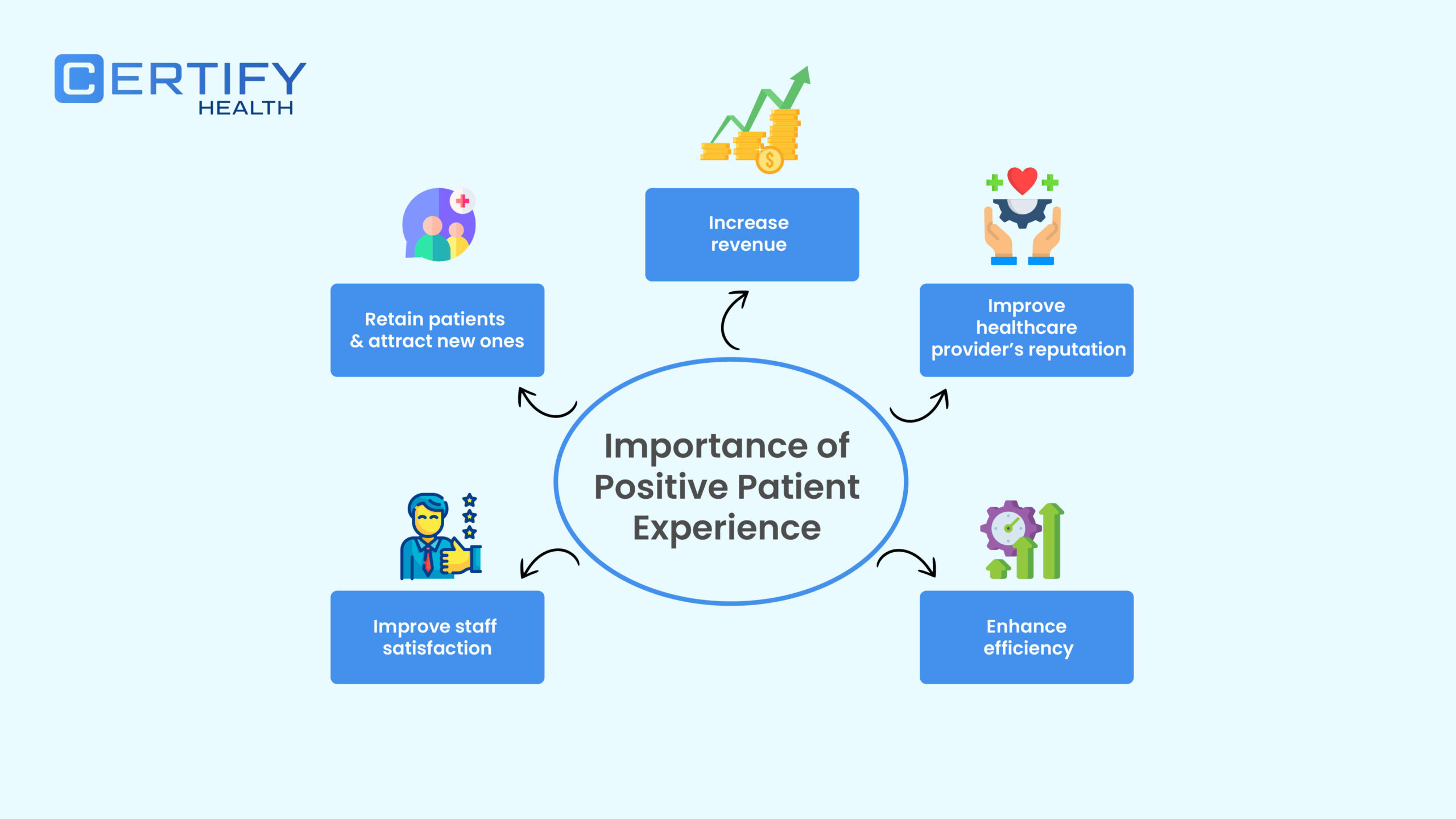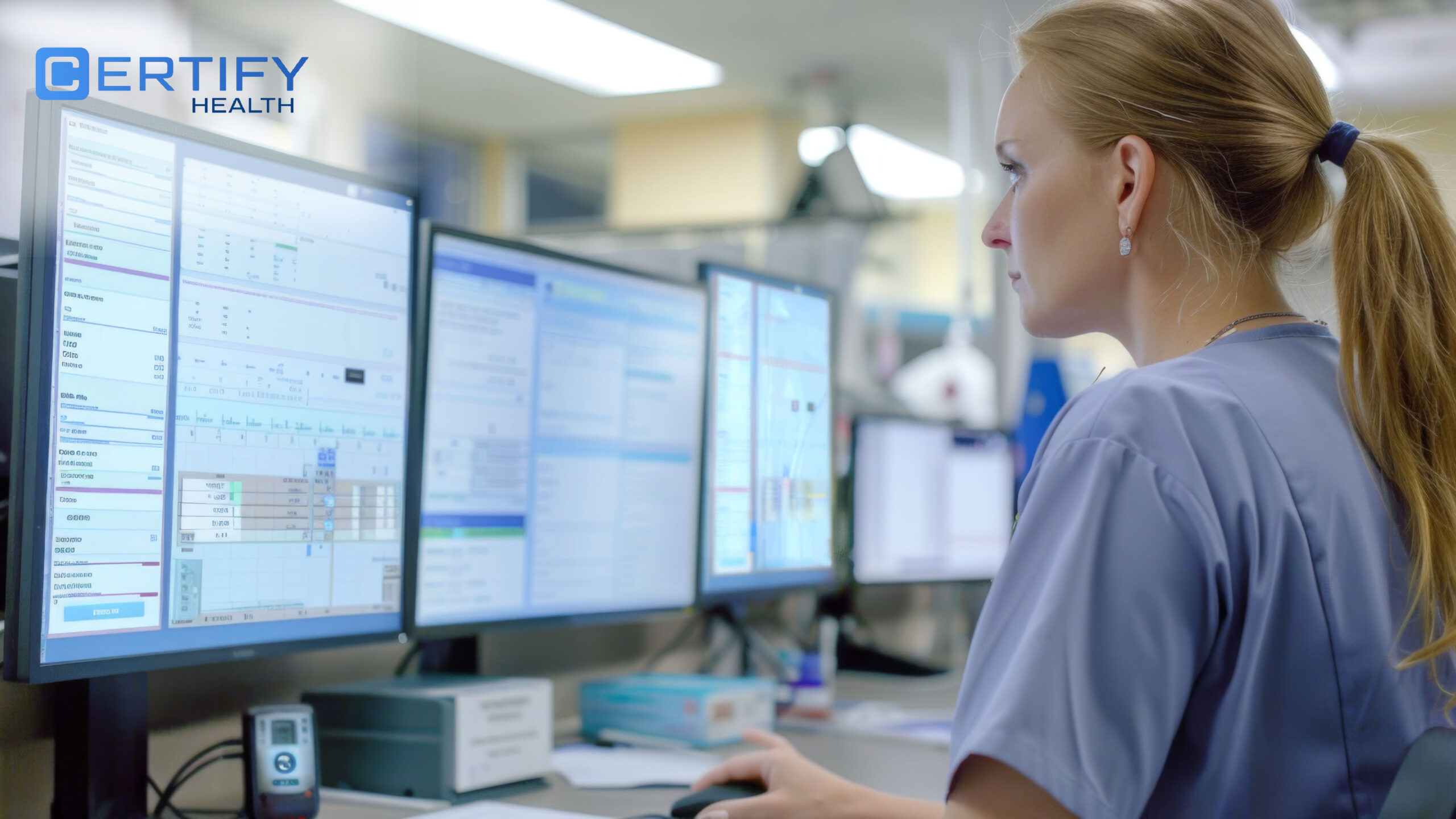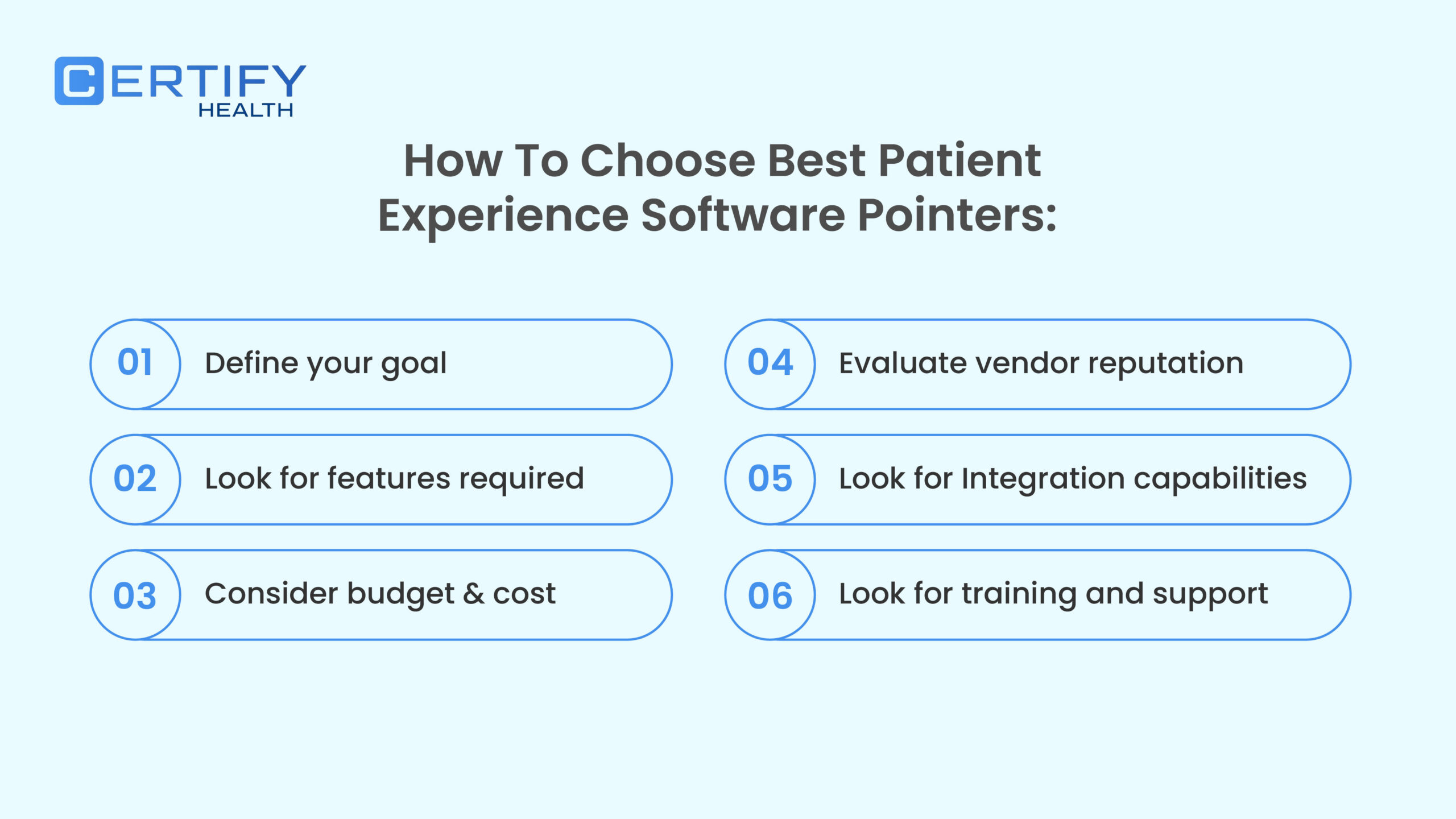Introduction
A patient walks into a healthcare center and has to wait in a long queue. The front desk hands them over ‘n’ number of forms to fill out. Once done, they sit and wait for their turn to see the doctor.
How does it sound? Frustrating, right? Long wait times, repetitive paperwork, and overwhelmed staff make the process inefficient.
Now, imagine a seamless check-in—online appointment booking, digital forms, and instant updates—no lines, no hassle. This is where Patient Experience Software steps in, transforming outdated processes into smooth, stress-free visits.
If you are looking for a solution like this, read this blog until the end. We have created this comprehensive guide on what is patient experience software, key benefits, how to choose one and implementation strategies.
Did you know
A report by Accenture revealed that 68% of patients consider the convenience of booking or canceling an online appointment when choosing a healthcare provider.
What is Patient Experience?

Patient experience is nothing but how the patient feels throughout their healthcare journey – from the moment of scheduling of an appointment to receiving care and exiting the care center. Patient experience is dependent on communication with staff, doctors, wait time, ease of booking appointments, and how satisfied they are with their care.
To improve patient experience, healthcare providers need to prioritize relationships building, leveraging technology for patient convenience, and boost health outcomes.
Improving patient experience is important as it helps:
- Increase revenue
- Improve healthcare provider’s reputation
- Enhance efficiency
- Improve staff satisfaction
- Retain patients & attract new ones
What is Patient Experience Software?
Patient Experience Software, or Patient Experience Management Software, transforms how healthcare providers interact with patients, making processes smoother, more efficient, and more personalized. Reducing wait times, automating administrative tasks, and improving communication enhances patient satisfaction and care quality.
This software benefits various healthcare entities, including:
General Hospitals – Streamlining patient intake, reducing paperwork and improving overall hospital efficiency.
Specialty Hospitals – Enhancing patient engagement with tailored care experiences.
Specialty Clinics – Ensuring better coordination and follow-ups for niche treatments.
NGOs & Healthcare Associations – Improving accessibility and outreach efforts for patient care.
Multispecialty Groups – Centralizing patient interactions for seamless, high-quality care across specialties.
Why Use Patient Experience Software?
1. Enhancing Patient Satisfaction

Your patients seek not just treatment but a seamless, trustworthy care experience. They may have busy schedules, but a simple appointment reminder, a warm interaction with your staff, and a hassle-free journey through their care make all the difference.
Patient experience software helps you meet these expectations by enabling personalized communication, easy access to care, and timely interventions for better health outcomes. When patients move smoothly through your facility, receiving the care they anticipate, they leave satisfied—and are far more likely to return.
Satisfied patients are more likely to stay loyal, share their feedback on your website or GMB, recommend your practice, and enhance your healthcare facility’s reputation.
Did you know
A YouGov survey of 1,000+ U.S. consumers found that over 70% rely on patient reviews when choosing a healthcare provider or location.
This makes it clear that your practice’s online reputation matters. To retain or attract patients, you must leverage patient experience software that streamlines every touchpoint, improve patient satisfaction score (PSS), and encourage retention and referrals.
2. Augmenting Patient Engagement

Patient engagement plays a crucial role in healthcare, you want to know how? Engaged patients are more likely to show up for appointments, follow their care plan, and stay proactive about their health.
With patient experience software, you can boost engagement by simplifying patient scheduling, sending timely follow-ups, and collecting feedback. These actions reduce no-show rates, improve health outcomes, and strengthen patient-provider relationships.
Pro tip:
According to a Business Wire article, 30% of patients said that lengthy wait times caused them to leave an appointment.
This underscores the importance of using technology that empowers patient engagement—enabling them to schedule appointments easily, receive timely reminders, and even get real-time updates on their queue position. All of which play a key role in reducing no-show rates and enhancing the overall patient experience.
3. Improving Administrative Efficiency

Your staff plays a very important role in the patient experience, but they have no time to focus on patients if they are stuck in administrative tasks. Operational inefficiencies make both staff and patients frustrated.
Tasks like paper form filling, manual insurance verification, billing, etc., consume a lot of time and make your staff slower. However, with patient experience software, your staff no longer need to worry about administrative tasks.
This software automates tasks like patient scheduling, patient check-ins, insurance verification, and billing to reduce manual overload, freeing up your staff to deliver better care to the patients.

Results:
CERTIFY Health’s Kiosk Check-Ins
At a pilot group of 11 clinics, CERTIFY Health’s kiosk solution processed 47,000 check-ins over four months—slashing the average patient check-in time from 12 minutes to 20 seconds. That translates to a massive reduction in waiting and paperwork, giving staff more time to focus on care rather than admin tasks.
4. Increasing Patient Loyalty and Retention

A positive patient experience is a key to long-term relationships and patient loyalty. If your patients feel heard, valued and most importantly, cared for, then they will keep choosing your healthcare practice for their future needs.
The seamless patient journey from scheduling to check-ins, insurance verification to treatment, everything is important to build a positive patient experience. A happy patient becomes advocates, share their experience with friends, positive reviews, and ratings on your website or Google my business, thus attracting new patients to your practice.
5. Ensuring Compliance and Data Security

Healthcare providers must not overlook compliance and data security. There are strict guidelines like HIPAA, GDPR, and No Surprise Act, made for safety and security of patient data and trust.
But adhering to these guidelines is not so easy, and that’s where come’s the need for patient experiences software. It helps you to adhere to compliance and stay updated with new regulatory requirements automatically. This reduces risk of data breaches, legal violations, and penalties. Patients feel more confident knowing their personal health information is in safe hands.
6. Optimize (RCM) Revenue Cycle Management

Financial stability is the backbone of healthcare, yet inefficient billing, insurance verification delays, claim denials and late payments create serious disruptions in revenue cycle management. Without a streamlined revenue cycle, cash flow suffers—impacting operations and patient care.
Patient experience software helps reduce administrative burdens for your staff and automates billing, real-time insurance verification, and digital payment collection, ensuring timely payment collection. Practices can minimize errors, speed up reimbursements, and maintain financial health with a patient experience platform.
7. Strengthening Patient Provider Communication

Patient provider communication is very important to achieve your patient experience goals. If communication is not proper, it leads to misunderstandings, missed appointments, and compromised treatment outcomes.
The patient experience platform bridges the communication gap between patient and provider by enabling real-time messaging, automated reminders, and access to medical information. It ensures your patients remain engaged throughout their treatment journey.
When communication is seamless, patients feel more connected to their healthcare providers, leading to better relationships, increased trust, and higher satisfaction levels.
A Guide to Selecting the Best Patient Experience Software

1. Define Your Goals
Before diving into software options, take a moment to assess your needs. Ask yourself:
- What challenges are your practice facing? Are appointment no-shows, long wait times, or inefficient communication common?
- What are your patient experience goals? Do you want to improve administrative efficiency, automate processes, or enhance patient loyalty?
- How will the software help you achieve these goals?
Clearly defining these factors will ensure you select a solution that aligns with your practice’s needs.
2. Assess Features and Benefits
Not all patient experience platforms are created equal. Make sure the software you choose offers the following:
- Automated Scheduling & Reminders: Reduce missed appointments and improve patient engagement.
- Real-Time Messaging & Feedback: Strengthen patient provider communication and address concerns promptly.
- Seamless Integration: Ensure compatibility with existing systems like EHRs and billing software.
- Data Analytics & Reporting: Track key performance metrics and optimize patient care.
Matching the software’s capabilities with your practice’s specific needs is essential for maximizing its impact.
3. Consider Budget and Costs
While investing in the right patient experience software is crucial, budget constraints must be considered.
- Software Licensing Fees – Is it a one-time payment or a subscription model?
- Implementation & Training Costs – Will your staff require extensive training?
- Maintenance & Support Expenses – Are upgrades and troubleshooting included?
Striking a balance between affordability and essential features ensures long-term sustainability.
4. Evaluate Vendor Reputation
Choosing a reputable vendor is just as important as selecting the right software. A trustworthy provider should have the following:
- Positive Customer Reviews & Testimonials – Look for feedback from similar healthcare facilities.
- Industry Recognition & Certifications – Check for awards or endorsements that validate their expertise.
- Reliable Track Record – How long has the vendor been in business? Do they have proven success stories?
A vendor with a strong reputation guarantees reliability and ongoing support.
5. Prioritize Customer Support & Training
Even the best patient experience platform is ineffective without proper implementation. Ensure the vendor provides:
- Comprehensive Onboarding Assistance – A structured training plan for smooth adoption.
- Ongoing Support & Troubleshooting – Quick assistance for technical issues.
- Regular Updates & Feature Enhancements – Keeping the software up to date with the latest advancements.
A responsive support team ensures your practice can fully leverage the software for improved patient satisfaction and retention.
How to Implement Patient Experience Platform Successfully
Once you are done with choosing the right patient experience platform, the next step is implementation. And this is not as easy as simply installing software on your device; there’s more to it.
Let’s understand what a well-planned implementation strategy is.
1. Planning & Strategy
Before launching a patient experience platform, a clear roadmap is important.
- Know your objectives, such as patient satisfaction, streamlining staff workflows, or patient retention.
- Define the roles of your team members in ensuring accountability when handling the implementation task. Who will be coordinating with the vendor and helping with data migration or integration?
- Set realistic timelines for implementation and allocate necessary resources to minimize disruptions in your practice workflow during the transition to new software.
2. Educating & Training Staff
Even the best patient experience platform won’t deliver results if staff don’t use it effectively.
- Train your staff to use the software effectively to enhance patient provider communication and improve administrative efficiency.
- Vendor-led onboarding sessions ensure a smooth learning curve, helping staff utilize features like automated reminders and real-time messaging effectively.
- Whenever there is a new update or a feature that comes into use, give a proper brief on how to use it, make sure they are updated with new capabilities and ensure operational success.
3. Monitoring & Continuous Improvement
Implementation doesn’t end at deployment—it requires ongoing assessment and optimization.
- Keep an eye on performance metrics to see how it’s impacting patient engagement and satisfaction.
- Check-in with both staff and patients to gather feedback—what’s working well and what needs tweaking?
- Use these insights to refine workflows, augment efficiency, and stay aligned with your long-term patient experience goals.
CERTIFY Health’s Patient Experience Platform
CERTIFY Health isn’t just another patient experience platform—it’s a game-changer for hospitals, clinics, and healthcare facilities aiming to help you achieve your patient experience goals. From seamless digital check-ins and real-time insurance verification to effortless patient provider communication and payment collection, it takes the hassle out of staff operations.
And the impact? The numbers speak for themselves:
- Over 10.5 million patients have checked in and scheduled appointments.
- More than 7 million patient payments are processed.
- 5 million+ patients registered and checked in using biometric authentication.
What Makes CERTIFY Health Unique?
CERTIFY Health is more than just software—it’s a complete patient experience solution designed to simplify and enhance every step of the patient’s journey. It offers solutions like:
Digital Patient Intake – No more paperwork; let patients complete forms digitally through their mobile or kiosk for a smoother check-in.
Automated Patient Scheduling – Reduce wait times and no-shows with a hassle-free, self-scheduling system.
Real-Time Insurance Verification – Instantly verify patient insurance to speed up approvals and avoid claims denial with accurate verification of patient’s insurance details.
Biometric Check-In – FaceCheck for secure, touchless check-ins, offering a seamless and safe patient experience.
Patient Payment Platform—Simplify medical billing, digital patient payment options, automated reminders, and varied patient payment modes.
Conclusion
We learned what is patient experience and how a patient experience platform helps streamline administrative workflows, enhance communication, and boost patient satisfaction, leading to better retention and engagement.
By investing in the right patient experience solution, you not only enhance patient care quality but also build lasting trust and loyalty.
CERTIFY Health is worth exploring if you are looking for the perfect patient experience platform. It offers a comprehensive solution designed to simplify workflows, enhance communication, and enhance patient satisfaction. Get in touch with us today to see how our platform can transform your healthcare practice!
FAQs
What is patient experience definition?
The definition of a patient’s experience is the sum of all interactions a patient has throughout his healthcare journey with care providers. It includes interactions with nurses, staff, doctors, etc.
It also includes aspects like ease of scheduling appointments, engagement, payment, wait time, treatment quality and overall satisfaction with care provided.
Why is patient experience important?
Patient experience is important for any healthcare provider’s business success. Patients who are happy with their journey from admission to discharge from the facility are considered to have good patient experience. This means that they are satisfied with healthcare providers, their treatment, and their health outcomes.
Healthcare organizations prioritize patient experience often see higher patient retention, better reviews, and improved operational efficiency. In a competitive healthcare landscape, delivering an excellent patient experience can differentiate providers and improve their reputation.
What are the 3 pillars of patient experience?
The three key pillars of patient experience are Communication, Comfort, and Care Coordination. Communication ensures clear, empathetic interactions between patients- providers. Comfort focuses on a welcoming environment and emotional well-being, while Care Coordination ensures seamless transitions and continuity in treatment across healthcare services.











